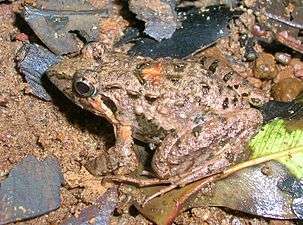Zakerana
| Zakerana | |
|---|---|
 | |
| Zakerana keralensis | |
| Scientific classification | |
| Kingdom: | Animalia |
| Phylum: | Chordata |
| Class: | Amphibia |
| Order: | Anura |
| Family: | Dicroglossidae |
| Subfamily: | Dicroglossinae |
| Genus: | Zakerana Howlader, 2011[1][2] |
| Type species | |
| Rana limnocharis syhadrensis Annandale, 1919 | |
| Diversity | |
| 20 species, see text | |
Zakerana is a genus of frogs in the Dicroglossidae family from southern Asia (Sri Lanka, the Indian subcontinent including Pakistan, Nepal, and Bangladesh), and Nepal and Bhutan. They are sometimes known as the South Asian cricket frogs.[2] The genus was described in 2011 and named in respect of the founder of Zoology department in Dhaka University Dr Kazi Zaker Hossain.[3]
Taxonomy
Zakerana were split off from Fejervarya in 2011. This was the culmination of recognizing that Fejervarya (as known before) was paraphyletic and consisted of two different groups; this recognition had already developing some years before. The sister taxon of Zakerana is Sphaerotheca.[2][4] Fejervarya, as currently defined, has a more eastern distribution than the southern Asiatic Zakerana, from eastern India eastwards.[4]
Species
There are 20 species in this genus:[2]
- Zakerana asmati (Howlader, 2011)
- Zakerana brevipalmata (Peters, 1871)
- Zakerana caperata (Kuramoto, Joshy, Kurabayashi, and Sumida, 2008)
- Zakerana dhaka (Howlader, 2016)
- Zakerana granosa (Kuramoto, Joshy, Kurabayashi, and Sumida, 2008)
- Zakerana greenii (Boulenger, 1905)
- Zakerana keralensis (Dubois, 1981)
- Zakerana kirtisinghei (Manamendra-Arachchi and Gabadage, 1996)
- Zakerana kudremukhensis (Kuramoto, Joshy, Kurabayashi, and Sumida, 2008)
- Zakerana mudduraja (Kuramoto, Joshy, Kurabayashi, and Sumida, 2008)
- Zakerana murthii (Pillai, 1979)
- Zakerana mysorensis (Rao, 1922)
- Zakerana nepalensis (Dubois, 1975)
- Zakerana nilagirica (Jerdon, 1854)
- Zakerana parambikulamana (Rao, 1937)
- Zakerana pierrei (Dubois, 1975)
- Zakerana rufescens (Jerdon, 1854)
- Zakerana sauriceps (Rao, 1937)
- Zakerana sengupti (Purkayastha and Matsui, 2012)
- Zakerana syhadrensis (Annandale, 1919)
- Zakerana teraiensis (Dubois, 1984)
Phylogeny
The following phylogeny of Zakerana is from Pyron & Wiens (2011).[5] 9 species are included.
| Zakerana |
| ||||||||||||||||||||||||||||||||||||||||||||||||
Howlader, et. al (2016) gives a different phylogeny.[6] 11 species are included.
| Zakerana |
| ||||||||||||||||||||||||||||||||||||||||||||||||||||||||||||
Both phylogenetic trees place Zakerana mudduraja as the most basal species.
Suwannapoom, et al. (2016) place Fejervarya chiangmaiensis as a sister taxon to a clade containing Zakerana syhandrensis, Zakerana granosa, and Zakerana pierrei.[7]
References
- ↑ Howlader, M. S. A. "Cricket frog (Amphibia: Anura: Dicroglossidae): two regions of Asia are corresponding two groups" (PDF). Bonnoprani: Bangladesh Wildlife Bulletin. 5 (1–2): 1–7.
- 1 2 3 4 Frost, Darrel R. (2014). "Zakerana Howlader, 2011". Amphibian Species of the World: an Online Reference. Version 6.0. American Museum of Natural History. Retrieved 6 February 2014.
- ↑ Hafez Ahmed. "Our Golden Boy". Daily-sun.com. Retrieved 2014-07-21.
- 1 2 Frost, Darrel R. (2014). "Fejervarya Bolkay, 1915". Amphibian Species of the World: an Online Reference. Version 6.0. American Museum of Natural History. Retrieved 6 February 2014.
- ↑ R. Alexander Pyron; John J. Wiens (2011). "A large-scale phylogeny of Amphibia including over 2800 species, and a revised classification of extant frogs, salamanders, and caecilians". Molecular Phylogenetics and Evolution. 61 (2): 543–583. PMID 21723399. doi:10.1016/j.ympev.2011.06.012.
- ↑ Howlader MSA, Nair A, Merilä J (2016) A New Species of Frog (Anura: Dicroglossidae) Discovered from the Mega City of Dhaka. PLoS ONE 11(3): e0149597. doi:10.1371/journal.pone.0149597
- ↑ Suwannapoom, C,, Z.-y. Yuan, N. A. Poyarkov, Jr., F. Yan, S. Kamtaeja, R. W. Murphy, and J. Che. 2016. A new species of genus Fejervarya (Anura: Dicroglossidae) from northern Thailand. Zoological Research/Dōngwùxué yánjiū. Kunming 37(6): 1–11.